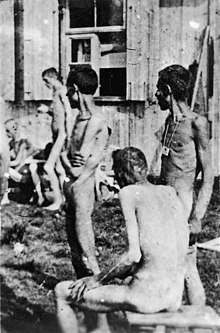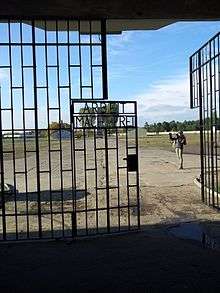Muselmann
Muselmann (pl. Muselmänner, the German version of Musulman, meaning Muslim) was a slang term used among captives of World War II Nazi concentration camps to refer to those suffering from a combination of starvation (known also as "hunger disease") and exhaustion and who were resigned to their impending death.[1][2] The Muselmann prisoners exhibited severe emaciation and physical weakness, an apathetic listlessness regarding their own fate, and unresponsiveness to their surroundings owing to the barbaric treatment by the fiendish Nazis and prisoner functionaries.[3]

Some scholars argue that the term possibly comes from the Muselmann's inability to stand for any time due to the loss of leg muscle, thus spending much of the time in a prone position, recalling the position of the Musulman (Muslim) during prayers.[4] It has also been suggested by Giorgio Agamben that the term hails from the Islamic fatalism which characterizes Sunnite orthodoxy, i.e. the idea that there are no such things as causality but that God performs every occurrence in the world, meaning that everything including men simply undergoes the workings of God and does not act on its own.[5]
Usage of the term in literature
The American psychologist David P. Boder assisted in identifying the term musselman when in 1946 he conducted interviews with camp survivors in Europe. He asked them to describe, spell and pronounce the word for camp inmates so emaciated that they had lost the will to live.[6][7]
Primo Levi tried to explain the term (he also uses Musselman), in a footnote of If This Is a Man (the commonly found English translation is titled Survival in Auschwitz), his autobiographical account of his time in Auschwitz:[1]
This word ‘Muselmann’, I do not know why, was used by the old ones of the camp to describe the weak, the inept, those doomed to selection.
“Their life is short, but their number is endless: they, the Muselmanner, the drowned form the backbone of the camp, an anonymous mass, continually renewed and always identical, of non men who march and labour in silence, the divine spark dead within them, already too empty to really suffer. One hesitates to call them living: one hesitates to call their death death, in the face of which they have no fear, as they are too tired to understand…"- Primo Levi, If This Is a Man
The psychologist and Auschwitz survivor Viktor Frankl, in his book Man's Search for Meaning, provides the example of a prisoner who decides to use up his last cigarettes (used as currency in the concentration camps) in the evening because he is convinced he won't survive the Appell (roll call assembly) the next morning; his fellow captives derided him as a Muselmann. Frankl compares this to the dehumanized behavior and attitudes of the kapos.[8]
Italian philosopher Giorgio Agamben defined his key examples of 'bare life', the Muselmann and the patient in an overcoma, in relation to their passivity and inertia. The Muselmann was for him "a being from whom humiliation, horror and fear had so taken away all consciousness and personality as to make him absolutely apathetic", "[m]ute and absolutely alone ... without memory and without grief."[9]
The testimonial of the Polish witness, Adolf Gawalewicz, Refleksje z poczekalni do gazu: ze wspomnień muzułmana ("Reflections in the Gas Chamber's Waiting Room: From the Memoirs of a Muselmann"), published in 1968, incorporates the term in the title of the work.[10]
Canadian Jewish author Eli Pfefferkorn published a novel in 2011 with title The Muselmann at the Water Cooler.[11]
Origin and alternative slang terms
The term spread from Auschwitz-Birkenau to other concentration camps. Its equivalent in the Majdanek concentration camp was Gamel (derived from German gammeln - colloquial for "rotting") and in the Stutthof concentration camp, Krypel (derived from German Krüppel, "cripple"). When prisoners reached this emaciated condition, they were selected by camp doctors and murdered by gas, bullet or various other methods.
In the Soviet Gulag, the term dokhodyaga (Russian: доходяга - goner) was used for someone in a similar situation.
Criticism
The word Musselman is frequently used in a demeaning manner. For example, in his book Man's Search for Meaning author Victor Frankl mentions the frequent use of the word Musselman in the concentration camps of the Nazi regime. In Man's Search for Meaning, Frankl berates the attitudes of those who fit his definition of the word Musselman by associating the word with those who are unable to fight the oppressive tactics utilized by the Nazis.[12]
Action 14f13


Those prisoners considered Muselmänner and thus unable to work were also very likely to be labelled "excess ballast" inside the concentration camps.[13] In spring 1941 Heinrich Himmler expressed his desire to relieve concentration camps of sick prisoners and those no longer able to work.[14] Action T4, a "euthanasia" programme for mentally ill, disabled and other inmates of hospitals and nursing homes who were deemed unworthy of life, was extended to include the weakest concentration-camp prisoners.[15][16] Himmler, together with Philipp Bouhler, transferred technology and techniques used in the Aktion T4 programme to the concentration camps, and later to Einsatzgruppen and death camps.[17][18]
The first concentration-camp victims of this program were gassed by carbon monoxide poisoning and the first known Selektion took place in April 1941 at Sachsenhausen concentration camp. By the summer of 1941 at least 400 prisoners from Sachsenhausen had been "retired". The scheme operated under the Concentration Camps Inspector and the Reichsführer-SS under the name "Sonderbehandlung 14f13".[19] The combination of numbers and letters derived from the SS record-keeping system and consists of the number "14" for the Concentration Camps Inspector, the letter "f" for the German word "deaths" (Todesfälle) and the number "13" for the cause of death, in this case "special treatment", a bureaucratic euphemism for gassing.[20]
See also
- KZ Syndrome
- Ka-tzetnik
Further reading
- Israel Gutman, Encyclopaedia of the Holocaust, New York: Macmillan (1990), vol. 3. p. 677 (in Hebrew)
- Wolfgang Sofsky, The Order of Terror: The Concentration Camp, Princeton: Princeton University Press (1999), pp. 25, 199-205.
- Giorgio Agamben, The Witness and the Archive, book.
- Jeremy Adler, Die Philologie des Boesen, Lecture, Leipzig, 2019.
References
- Levi, Primo (1987). "The Truce". If This Is a Man. Abacus. p. 94. ISBN 0349100136.
- Danuta Czech (1996). Auschwitz: Nazi Death Camp. Auschwitz-Birkenau State Museum. ISBN 978-83-85047-56-8.
- Muselmann definition Johannes Kepler University of Linz, official website. Insitut für Sozial und Wirtschaftsgeschichte. Retrieved November 30, 2010
- Muselmann definition (PDF) Yad Vashem, official website. Shoah Resource Center, The International School for Holocaust Studies. Retrieved November 30, 2010
- Mills, Catherine (1999). "An Ethics of Bare Life: Agamben on Witnessing". www.borderlands.net.au. Retrieved 2019-08-08.
- Ritchie, Donald A. (2011). The Oxford Handbook of Oral History. Oxford University Press, USA. pp. 245 ff. ISBN 978-0-19-533955-0.
- Alan Rosen (18 October 2010). The Wonder of Their Voices: The 1946 Holocaust Interviews of David Boder. Oxford University Press. pp. 306 ff. ISBN 978-0-19-978076-1.
- Frankl, Viktor E. (1 June 2006). Man's Search for Meaning. Beacon Press. ISBN 978-0-8070-1428-8.
- Elliott, Jane (Summer 2013). "Suffering Agency: Imagining neoliberal personhood in North America and Britain". Social Text (31): 86.
- Gawalewicz, Adolf (1968). Refleksje z Poczekalni do Gazu: ze wspomnień muzułmana. Cracow: Wydawnictwo Literackie. p. 165.
- Pfefferkorn, Eli (2011). The Müselmann at the Water Cooler. Academic Studies Press. ISBN 978-1936235667.
- Frankl, Viktor Emil (2006). Man's Search for Meaning. Beacon Press. ISBN 9780807014295.
isbn:080701429X.
- Robert P. Watson (26 April 2016). The Nazi Titanic: The Incredible Untold Story of a Doomed Ship in World War II. Da Capo Press. pp. 65–. ISBN 978-0-306-82490-6.
- Stephen Goodell; Sybil Milton; United States Holocaust Memorial Museum (1995). 1945: the year of liberation. U.S. Holocaust Memorial Museum. ISBN 978-0-89604-700-6.
- S. Kühl (7 August 2013). For the Betterment of the Race: The Rise and Fall of the International Movement for Eugenics and Racial Hygiene. Springer. pp. 126–. ISBN 978-1-137-28612-3.
- United States Holocaust Memorial Museum (2002). The Holocaust and History: The Known, the Unknown, the Disputed, and the Reexamined. Indiana University Press. pp. 332–. ISBN 0-253-21529-3.
- David Nicholls (2000). Adolf Hitler: A Biographical Companion. ABC-CLIO. pp. 34–. ISBN 978-0-87436-965-6.
- Henry Friedlander (9 November 2000). The Origins of Nazi Genocide: From Euthanasia to the Final Solution. Univ of North Carolina Press. pp. 142–. ISBN 978-0-8078-6160-8.
- Peter Hayes (17 January 2017). Why?: Explaining the Holocaust. W. W. Norton. pp. 86–. ISBN 978-0-393-25437-2.
- Michael Burleigh; Wolfgang Wippermann (7 November 1991). The Racial State: Germany 1933-1945. Cambridge University Press. pp. 161–. ISBN 978-0-521-39802-2.